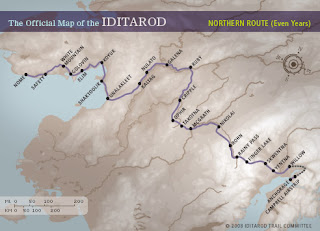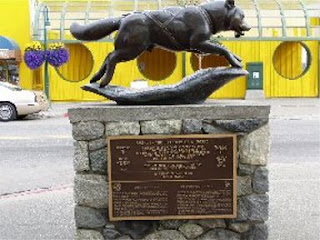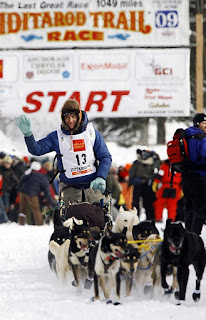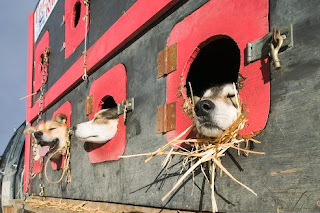From Anchorage, in south central Alaska, to Nome on the western Bering Sea coast, each team of 12to 16 dogs and their musher, cover over 1150 miles in 10 to 17 days.
It has been call the "Last Great Race on Earth" and it has won worldwide acclaim and interest. German, Spanish, British, Japanese and American film crews have covered the event. Journalists from outdoor magazines, adventure magazines, newspapers and wire services flock to Anchorage and Nome to record the excitement. It's not just a dog sled race. It's a race in which unique men and women compete. Mushers enter from all walks of life. Fishermen, lawyers, doctors, miners, artists, natives, Canadians, Swiss, French and others, men and women each with their own story, each with their own reasons for going the distance. It's a race organized and run primarily by volunteers, thousands of volunteers, men and women, students and village residents. They man headquarters at Anchorage, Fairbanks, Juneau, Nome and Wasilla. They fly volunteers, veterinarians, dog food and supplies. They act as checkers, coordinators, and family supporters of each musher.
 |
| Northern Route |
The Spirit of Alaska! More Than a Race...a Commemoration
The race pits man and animal against nature, against wild Alaska at her best and as each mile is covered, a tribute to Alaska's past is issued. The Iditarod is a tie to a commemoration of that colorful past.
The Iditarod Trail, now a National Historic Trail, had its beginnings as a mail and supply route from the coastal towns of Seward and Knik to the interior mining camps at Flat, Ophir, Ruby and beyond to the west coast communities of Unalakleet, Elm, Golovin, White Mountain and Nome. Mail and supplies went in. Gold came out. All via dog sled. Heroes were made, legends were born.
In 1925, part of the Iditarod Trail became a life saving highway for epidemic stricken Nome. Diphtheria threatened and serum had to be brought in...again by intrepid dog mushers and their faithful hard driving dogs.
The Iditarod is a commemoration of those yesterdays, a not so distant past that Alaskans honor and are proud of.
An Event for All Alaska
Anchorage is the starting line...a city of over 250,000 people, street lights, freeways and traffic. From there the field of dog teams which grow in number each year run to Eagle River, Checkpoint #1. After a restart in the Matanuska Valley at Wasilla, the mushers leave the land of highway and bustling activity and head out to the Yenta Stations Roadhouse and Skewentna and then up. Through Finger Lake, Rainy Pass, over the Alaska Range and down the other side to the Kuskokwin River...Rohn Roadhouse, Nikolai, McGrath, Ophir, Cripple, Iditarod and on to the mighty Yukon...a river highway that takes the teams west through the arctic tundra.
The race route is alternated every other year, one year going north through Cripple, Ruby and Galena, the next year south through Iditarod, Shageluk, Anvik.
Finally, they're on the coast...Unalakleet, Shaktoolik, Koyuk, Elm, Golovin, White Mountain and into Nome where a hero's welcome is the custom for musher number 1 or 61!
The route encompasses large metropolitan areas and small native villages. It causes a yearly spurt of activity, increased airplane traffic and excitement to areas otherwise quiet and dormant during the long Alaskan winter. Everyone gets involved, from very young schools children to the old timers who relive the colorful Alaskan past they've known as they watch each musher and his team. The race is an educational opportunity and an economic stimulus to these small Alaskan outposts.
The "I" logo, a trademark of the Iditarod Trail Committee Inc. and the Iditarod Race, was designed by Alaskan artist Bill Devine in the early years of the race. The design is done on a white background with blue thread for the dog and inner outline. The Outer outline is done in red. The design is used on a shield and was used on wooden trail markers in the earlier races.
On the Trail
Every mushers has a different tactic. Each one has a special menu for feeding and snacking the dogs. Each one has a different strategy...some run in the daylight, some run at night. Each one has a different training schedule and his own ideals on dog care, dog stamina and his own personal ability.
Some mushers spend an entire year getting ready and raising the money needed to get to Nome. Some prepare around a full time job. In addition to planning the equipment and feeding needs for up to three weeks on the trail, hundreds of hours and hundreds of miles of training have to be put on each team.
There are names which are automatically associated with the race...Joe Redington, Sr., co founder of the classic and affectionately known as "Father of the Iditarod". Rick Swenson from Two River, Alaska, the only five time winner, the only musher to have entered 20 Iditarod races and never finished out of the top ten. Dick Mackey from Nenana, who beat Swenson by one second in 1978, to achieve the impossible photo finish after two weeks on the trail. Norman Vaughan who at the age of 88, has finished the race four times and led an expedition to Antarctica in the winter of 93-94. Four time winner, Susan Butcher, was the first woman to ever place in the top 10. And of course, Libby Riddles, the first woman to win the Iditarod in 1985.






Comments
Post a Comment